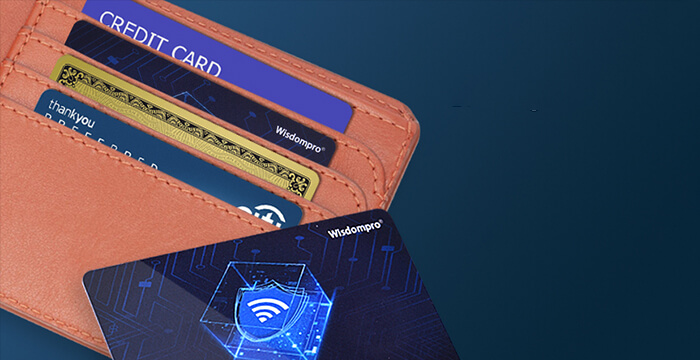The use of RFID-Karten is becoming more commonplace. These cards are used in numerous applications, including access control, identity verification, and payment processing.
However, RFID cards are also susceptible to fraud and skimming. Criminals can use handheld devices to scan and clone the information on RFID cards. This can lead to identity theft, financial loss, and other problems.
To protect yourself from RFID skimming, you can use an RFID card blocker. Wondering how RFID card blockers work? Here’s a comprehensive guide:
What is RFID Blocking?
Before we discuss how RFID blocking works, let’s first define the term. RFID blocking refers to using any material or device to prevent RFID signals from being read or transmitted.
Ideally, an RFID card (without a blocker) can be read even when in the pocket or handbag. All that’s needed is an RFID reader within a few inches of the card.
This poses a serious security risk as criminals can use handheld RFID readers to scan your card information without you even knowing it. They will then use this information to commit fraudulent activities.
To prevent this from happening, you need to block the RFID signals produced by RFID readers, ensuring they do not excite the cards’ antenna. This will make it impossible for the card to be read or cloned.
What is an RFID Card Blocker?
An RFID card blocker is any material or device that can block RFID signals. These blockers come in a variety of forms, including sleeves and wallets.
They are typically made from metal or a conductive material that can reflect or absorb RFID signals. This material is then placed between the card and the reader, ensuring that the card does not receive or transmit any signals.
RFID card blockers come in different shapes and sizes, depending on the type of card you want to protect. For example, credit card blockers are usually small and thin enough to fit into a wallet.
Meanwhile, passport blockers are larger as they need to cover the entire document. There are also special RFID-blocking sleeves that can be used to protect multiple cards at once.
How RFID Card Blockers Work
Ein RFID system consists of three components: an antenna, a transponder, and a reader. The antenna emits radio waves that activate the transponder. Once activated, the transponder sends out its stored information to the reader.
To block RFID signals, you need to prevent the antenna from emitting radio waves or the transponder from receiving them. This can be done by creating a physical barrier between the card and the reader. They are two types of blockers, including passive and active:
- Passive Blockers
Because the criminals have the RFID reader/antennae, the blocker needs to be placed on or around the card. The most common type of RFID blocker is a sleeve. This is a thin cover that goes over the entire card, preventing it from being read.
Another popular type of blocker is a wallet. These work in a similar way to sleeves but can also protect other items in your wallets, such as cash and IDs.
The most effective RFID blockers are made from metal or conductive material. This material will reflect or absorb the RFID signals, making it impossible for the card to be read.
Some common conductive materials used in RFID blockers include aluminum foil, copper, and carbon fiber. You can also find RFID-blocking fabrics that are woven with conductive materials.
- Active Blockers
Active blockers usually emit their RFID signals. These devices work by emitting radio waves that confuse or overwhelm the transponder. This makes it impossible for the transponder to send its stored information to the reader.
Besides reflecting or absorbing RFID signals, active blockers jam skim signals. This incapacitates the RFID reader, making it impossible for criminals to skim your card information.
Due to their two-way protection, active blockers are more expensive than passive blockers. However, they are worth the investment as they offer better protection against skimming.
Are RFID Card Blockers Effective?
RFID card blockers are an effective way to protect your cards from skimming. However, it’s important to note that they are not 100% foolproof.
This is because the size and material of the blocker will determine its effectiveness. For example, a thin sleeve made from aluminum foil may not be able to block all RFID signals.
To ensure maximum protection, you should look for an RFID blocker that is made from a conductive material and is the right size for your card. You can also purchase an RFID-blocking wallet to protect multiple cards at once.
When used properly, RFID blockers can help to protect your cards from skimming and other malicious activities.
Benefits of Using RFID Card Blockers
There are several benefits of using RFID card blockers, including:
- Protect Personal Data. Passports and credit cards store personal information that can be used to commit fraud. By blocking RFID signals, you can prevent this information from being accessed by criminals.
- Prevent Card Cloning. RFID skimmers can clone your card’s information and use it to make unauthorized purchases. By blocking the RFID signal, you can prevent your card from being cloned.
- Stop Unwanted Transactions. Some RFID-enabled devices can make transactions without your knowledge or consent. These are known as “contactless” payments. By using an RFID blocker, you can prevent these unwanted transactions from taking place.
- Reduce Identity Theft. Identity theft is a serious problem with devastating effects on your life. By blocking RFID signals, you can help to reduce the risk of identity theft.
- Make Travel Safer. When traveling, it’s important to keep your passport and other documents safe. RFID blockers can help to protect your documents from being scanned and stolen while you’re on the go.
These cards work against both NFC and RFID signals, making them ideal for use in any situation where you need to protect your information. They are available in a variety of sizes and shapes to fit any card, and they can be used with or without a wallet.
You can buy them from a variety of retailers, both online and in-store. When shopping for RFID blockers, be sure to look for ones that are made from conductive materials and are the right size for your card.


